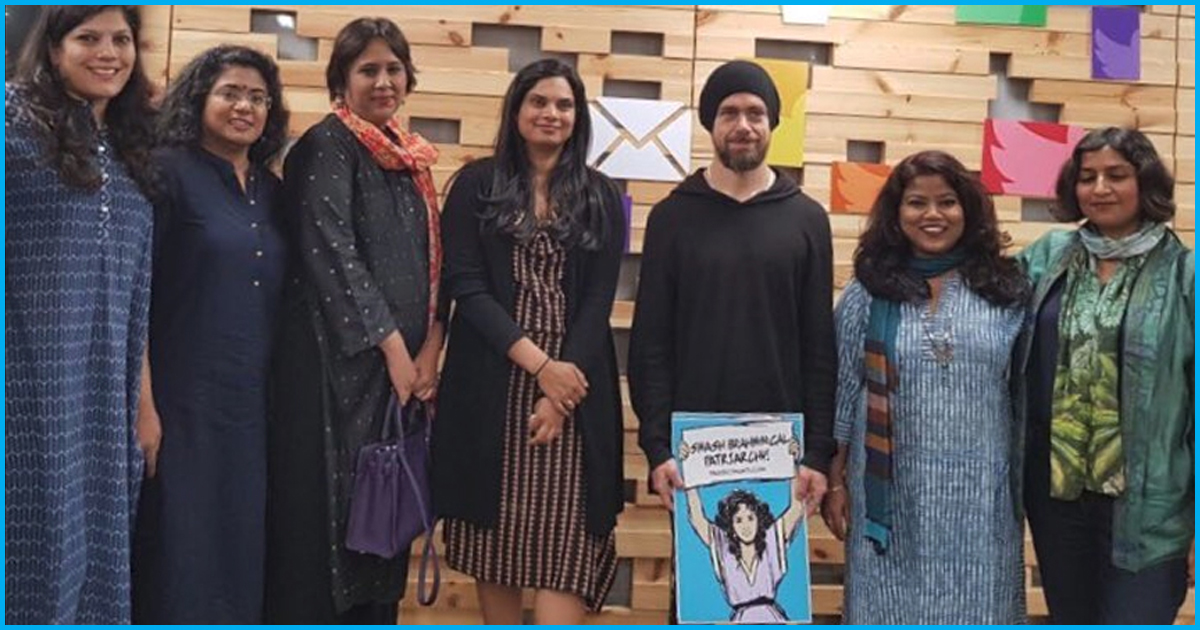
'Twitter Is Anti-Hindu, Hindus Are In Danger,' Jack Dorsey's Picture Scares Nationalists
22 Nov 2018 12:47 PM GMT
Twitter never has a boring day, be it making memes, or starting a war of words. This time, it is Twitter’s CEO Jack Dorsey who has found himself surrounded in controversy. He was recently in India and met a few women journalists in an off-the-record conversation. Although it was a hush-hush event, a picture of their meet made way to the public and woke up warriors of ‘Hindurashtra’.
In the picture, Jack can be seen holding a poster. The poster read “Smash Brahminical Patriarchy”. While some of them took offence from the word ‘smash’ and deduced that he was literally declaring war on Brahmins, others termed Jack as ‘Hinduphobic’ and furiously smashed their keyboards to save ‘Brahmins’ and the ‘Hindurashtra’.
Well, firstly, it is important to mention why he was clicked with that picture. Twitter justified that he was given the poster while he was meeting these women. While some people immediately decided to boycott Twitter, others said that he could have just smashed patriarchy, why endanger brahmins in the process of doing so.
Some said that Brahmins lack privileges in India after Independence and insisted that they are the minorities and the Twitter CEO is deliberately spreading hate against the religion. Some said that it was Twitter’s agenda for a long time to endanger Hindus and spread hate against Brahmins. Others were worried that their pro-Hindu content was being deleted by Twitter, which made them believe that it is truly a conspiracy against Brahmins.
We cannot normalize hating on a group exclusively.. If there's patriarchy why only target brahmins? and your excuse that Brahmanical patriarchy does not refer to Brahmins is BS. How about if I say Smash Christian assholery? Would I be referring to Hindus? 1/2
— jug uar (@jug_uar) November 21, 2018
This poster in the hands of @jack exposes the deep rooted hate @TwitterIndia has against the Hindus of the country. @amritat has got her anti Hindu and Anti India agenda implemented. The poster reads "Smash Brahmanical Patriarchy". pic.twitter.com/I5aG8Xeu4G
— Tejinder Singh Sodhi (@TejinderSsodhi) November 19, 2018
Don't know @jack why you want to smash Brahmins . We r Brahmins by just birth . No privelige is offered to Brahmins in India since Independence . Also the major Hindu temples are governed by government. Hence not able to understand how cum u want to smash Brahmanical patriarch
— manojpadhi (@manojpadhi8) November 21, 2018
Twitter has been exposed.
I have seen many pro-Hindu tags vanishing,despite huge number of tweets.
Now v know about this anti-Hindu platform.@jack has hurt sentiments of Hindus,by holding "smash brahmanical patriarchy" placard.
He should apologize,else @twitter should be banned https://t.co/GBUyTX46zw— Badri#Mission360+ (@badri4BJP) November 20, 2018
These people were not too unhappy when our Prime Minister Narendra Modi met the Twitter CEO a few days earlier and expressed happiness for being on the platform.
Delighted to meet you @jack! Happy to see the passion with which you’re leading @Twitter.
I enjoy being on this medium, where I’ve made great friends and see everyday the creativity of people. https://t.co/aUElNJyahk
— Narendra Modi (@narendramodi) November 13, 2018
“Smash Brahminical Patriarchy”
While it might be difficult for many ‘savarnas’ (upper caste), born in modern times, to understand why the word ‘brahminical’ is used in particular, it can be explained if we see the societal and cultural history of the ‘Hindu Samaj’.
“A marked feature of Hindu society is its legal sanction for an extreme expression of social stratification in which women and the lower castes have been subjected to humiliating conditions of existence. Caste hierarchy and gender hierarchy are the organising principles of the Brahminical social order,” wrote Uma Chakravarthy in Conceptualising Brahmanical Patriarchy in Early India: Gender, Caste, Class and State in 1993.
So, in India, when the caste system is so intricately ingrained in our social hierarchy, it is impossible to unlatch it from gender hierarchy. In the social order, it is the Brahmins or the ‘learned ones’ who held the cosiest position. Then came the Kshatriyas, Vaishyas and the Sudras.
The Brahmins, enjoying their position as the learned ones, have prevented education from reaching the lower castes. Subsequently, they have also controlled women in the name of religion and tradition. Mostly, it was the Brahmin man who would choose his wife. The woman could not say no even if she wanted to. It was the woman who was the entrance to the caste system. In a system like this, caste atrocity is directly proportional to violence against women.
Under the lieu of maintaining ‘pure blood’, the Brahmin patriarchs also instilled caste rigidity in marriages. It is through women that a lineage could be maintained, and it was the women who were not allowed to go outside caste and marry, as to not pollute the lineage. This is called endogamy, which is the essence of Brahminism. Endogamy is a term which refers to marrying only within the limits of a local community, clan, or tribe.
This hierarchy also made its way to other aspects of life. The Brahmin man was the head of the caste system and its sustenance. Years after years, women and other castes have been oppressed by the Brahmin man, hence it is called Brahminical patriarchy.
Hate speech and outrage
“I find the faux outrage over this poster an intentional distraction in that is meant to hide the structural privilege of the savarna castes. I think this is why equity feels like oppression for those who have been part of privileged castes for centuries,” said Dalit activist and artist in the United States, Thenmozhi Soundararajan who made the poster in 2016, to the Scroll.
Feminists use the term #BrahminicalPatriarchy to talk about how #brahminical norms determine #caste & #gender relations. It is fact not violence to name how one caste through scripture has held hegemonic power for centuries. #SmashBrahminicalPatriarchy @twitterindia @jack pic.twitter.com/SYQgLvnqBx
— Dalit Diva (@dalitdiva) November 20, 2018
The poster was a protest against the years of atrocity a Dalit woman has faced. Raising voice against years of oppression should not be considered as hate speech. After Jack Dorsey’s picture went viral, our Home Minister Rajnath Singh said strict action should be taken. But, why? How can a poster potentially harm the entire caste structure, that the Brahmins seem to categorically reject whenever there is a debate around reservation?
The Logical Indian Take
The term ‘patiarchy’ is a Greek word which means ‘rule of the father’ and broadly determines how the world is organised. Like it or not, the world still revolves around the needs of a man. No matter how many able women join the workforce with equal capability as that of the man, the gender pay gap is still a truth.
Now, patriarchy alone does not make sense. In a country like ours, where we value age-old traditions and rituals more than scientific knowledge and practical applications, women are not only controlled by the man but also by the social structure around them. The structure demands that Brahmins sit on top of the pedestal. Then, how is Brahminical patriarchy not the truth?
This, of course, necessarily does not mean that it is the Brahmins who are the only ones benefitting from the structure or they are the only ones oppressing. Dalit and Adivasi women have been oppressed for long. Till date, there are certain jobs that are only done by Dalits, like manual scavenging. People still marry within their own caste.
“I wish that these trolls were as incensed by the murder of 13-year-old Raja Lakshmi in Tamil Nadu, who was decapitated in front of her mother by her killer. When Savarna men face the same scale and frequency of gender-based violence that Dalit Bahujan and Adivasi women and non-binary people face then we can talk,” said Thenmozhi Soundararajan.
Another important aspect of this entire row is that Brahmins constitute more or less 5% of India’s population. Yet, they have more socio-economic dominance than any other caste or class. A study in 2006 found that Brahmins dominate white-collar jobs. It said that 84% of the 5.6 crore Brahmins in India were educated and about 13% of them were poor. Between the year 1950-2000, 47% of Chief Justices of India were Brahmins. Brahmins hold 49% of the top jobs in national journalism.
So, it is time to stop calling the poster a hate speech. It is important to understand the years of injustice lower castes had to face in the hands of savarnas. If we can still remember how our Muslim brethren destroyed Hindu temples, then we should also remember how Brahmins categorically treated lower castes and women with disgust and refused them a dignified way of life.
Also Read: Realities Of Caste Politics & Music: Not-So-Distant Cousins
 All section
All section













